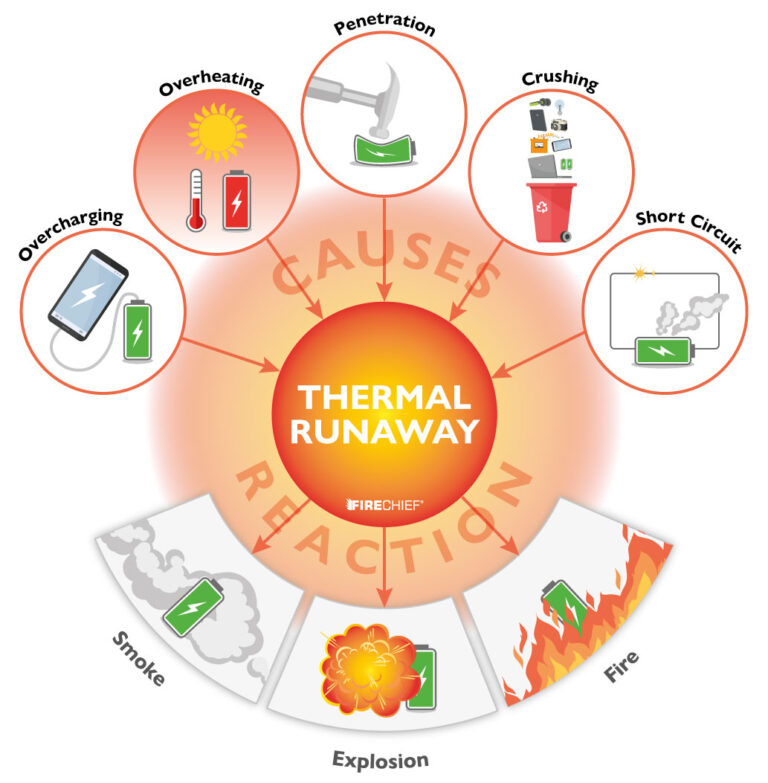Lithium Battery Fires - Unpacking the Science Behind Thermal Runaway

In an increasingly electrified world, lithium-ion batteries power everything from our smartphones to electric vehicles. While generally safe, these powerhouses are not without risk. Recent incidents, from e-bike battery fires to issues with energy storage systems, have put a spotlight on a phenomenon known as "thermal runaway" – the main culprit behind lithium battery explosions.
Delving into the Anatomy of a Lithium Battery Fire
To understand thermal runaway, we need to peek inside a lithium-ion battery. Imagine layers of positively and negatively charged materials separated by a thin, porous barrier. When you charge or discharge the battery, lithium ions flow between these layers, generating the electrical current we rely on.
Thermal runaway occurs when this normally controlled process goes haywire. Here's a simplified breakdown:
1. Initial Heat Generation:
Various factors can trigger this initial heating, including:
- Manufacturing Defects: Tiny metallic particles within the battery can create short circuits.
- Overcharging: Pushing too much energy into the battery can lead to internal damage and heat buildup.
- External Factors: High temperatures, like those encountered in a hot car, can also initiate the process.
2. The Domino Effect:
The initial heat, if not dissipated quickly enough, triggers a chain reaction:
- Higher temperatures cause the battery's internal components to break down, releasing more heat.
- This further breakdown generates flammable gases, increasing the internal pressure.
- Eventually, the battery's internal temperature reaches a critical point where the separator fails, causing a short circuit.
3. The Final Act: Explosion and Fire
The short circuit unleashes a massive amount of energy in a very short time, causing a rapid temperature spike. The flammable gases, now ignited, combust violently, leading to an explosion and potential fire.
Real-World Data: A Growing Concern
The issue of lithium battery fires is not merely theoretical. Data from fire departments and regulatory bodies paints a concerning picture:
- The US Fire Administration reported a 33% increase in lithium-ion battery fires between 2017 and 2020.
- The UK's Electrical Safety First found that faulty e-bike chargers were responsible for 1 in 10 fires in 2022.
- The US National Transportation Safety Board has investigated numerous incidents involving lithium battery fires in electric vehicles and e-scooters.
Addressing the Challenge: A Multi-Pronged Approach
Combating the risk of lithium battery fires requires a multifaceted strategy:
- Improved Battery Design and Manufacturing: Researchers are developing more robust separators, non-flammable electrolytes, and advanced cooling systems to enhance battery safety.
- Sophisticated Battery Management Systems: These systems monitor voltage, current, and temperature, preventing overcharging and discharging, and providing early warnings of potential issues.
- Stricter Safety Regulations and Testing: Governments and regulatory bodies are implementing stricter standards for battery production, transportation, and disposal to minimize risks.
- Consumer Awareness and Education: Educating consumers about safe battery handling practices, including proper charging, storage, and disposal, is crucial.
Concluding Thoughts: Navigating the Future of Energy Storage
Lithium-ion batteries are poised to play an even more critical role in our future, powering our homes, vehicles, and industries. However, understanding the risks associated with thermal runaway and taking proactive steps to mitigate them is crucial. By prioritizing safety through research, innovation, and responsible use, we can harness the full potential of these powerful energy storage devices while ensuring their safe integration into our lives.


















Comments ()